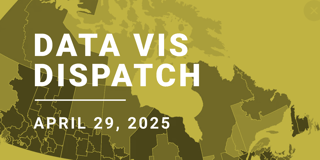Data Vis Dispatch, April 26
Welcome back to the 42nd edition of Data Vis Dispatch! Every week, we’ll be publishing a collection of the best small and large data visualizations we find, especially from news organizations — to celebrate data journalism, data visualization, simple charts, elaborate maps, and their creators.
Recurring topics this week include elections in France, war in Ukraine, and climate maps and illustrations.
This Sunday was the second round of voting in the French presidential election:





In 2017, Emmanuel Macron won the presidency with 66% of the vote. This year, he defeated Marine Le Pen for a second time — but the margin has narrowed:


Compared to 2017, Macron lost ground in every community district. Meanwhile, Le Pen finished with her party's strongest-ever results:



Rural, poorer, and middle-aged voters were more likely to support Le Pen:


Meanwhile, turnout was near a record low:




Russia continues its invasion of Ukraine, with fighting now concentrated in the country's east:




Weeks of siege have left the city of Mariupol in ruins:


This map-filled story from Le Monde puts the invasion in a recent historical context of other Russian war:
And a steady stream of Ukrainian civilians continue to flee the country, while Russia stirs up tension in Moldova's separatist region:


Climate visualizations this week included maps of transportation in Portland, Oregon and forest zones in Canada. Scroll down to the section "What else we found interesting" for more beautiful climate illustrations and interactives:



Congressional redistricting continues in the U.S., and primary elections are starting to heat up:


COVID charts this week showed us an economy back to normal in some ways (with a lot less Zoom and Netflix) but still not in others (with few office workers back to their old schedules):




Other visualizations covered everything from rising rents to diversity at elite public high schools to habitats for right whales:





What else we found interesting




Applications are open for...
- A data and graphics reporter at Politico
- Participants in the Data Institute workshop
- Motion graphics reporters at The Washington Post
- A Paris-based and a Washington-based data journalist at Agence France-Presse
- A senior data visualization developer, product specialist and evangelist, and customer success and support specialist at Datawrapper!
Help us make this dispatch better! We'd love to hear which newsletters, blogs, or social media accounts we need to follow to learn about interesting projects, especially from less-covered parts of the world (Asia, South America, Africa). Write us at hello@datawrapper.de or leave a comment below.



